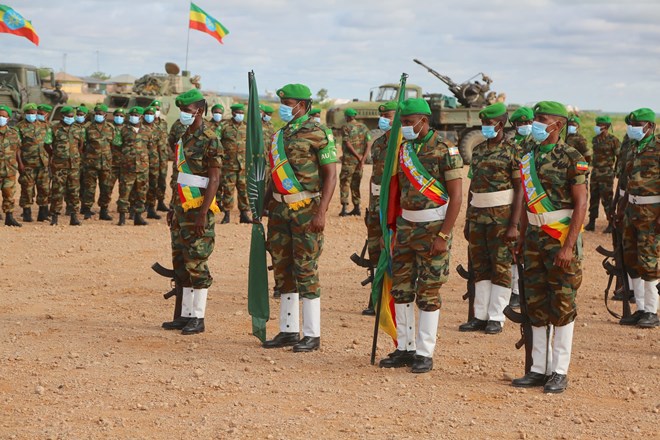
Monday August 26, 2024

Ethiopian troops stand in formation during a ceremony in Beledweyne, Somalia, on May 3, 2021. They were awarded African Union medals for their significant contributions to peace and stability in the region. Deployed under AMISOM Sector 4, the Ethiopian forces collaborated with the Djibouti Armed Forces (DJAF) and the Somali National Army in efforts to degrade Al-Shabaab terrorists in the Hiraan region. CREDIT / ATMIS
Mogadishu (HOL) — The African Union (AU) and United Nations (UN) are pressing forward with a new peacekeeping mission in Somalia despite facing hurdles as tensions with Ethiopia threaten to undermine efforts to combat the al-Shabaab insurgency. The new mission, set to replace the current peacekeeping force by the end of 2024, comes at a critical time for Somalia, with regional power struggles jeopardizing an already volatile situation.
AUSSOM is slated to take over from ATMIS, which has gradually reduced troop numbers since 2023. Initially, ATMIS deployed over 20,000 troops, but this number has been scaled back to 12,626 personnel, who will remain in place until the mission concludes. AUSSOM will maintain a similar force level, deploying 11,911 personnel across four sectors in Somalia, focusing on supporting Somali forces and enhancing civil-military relations to strengthen national conflict management capacities.
The transition marks a strategic shift for the AU, with AUSSOM prioritizing peace-building—strengthening Somalia’s capacity to manage its own conflicts—over direct state-building. The responsibility for developing government institutions now lies with the Federal Somali Government(FGS) and international partners, a notable departure from the more hands-on approach of previous missions like ATMIS and AMISOM.
For the first time, Egypt has committed to contributing troops to an AU mission in Somalia, signalling its deepening interest in the Horn of Africa. Egypt’s involvement is seen as an effort to bolster its influence in the Horn of Africa, particularly in light of its ongoing disputes with Ethiopia over the Grand Ethiopian Renaissance Dam (GERD). By reopening its embassy in Mogadishu and signing a defence pact with Somalia in August 2024, Egypt seeks to enhance its influence in a region increasingly defined by competition with Ethiopia.
Meanwhile, Ethiopia, a key contributor to ATMIS, has yet to confirm its participation in AUSSOM. Relations between Somalia and Ethiopia have become increasingly strained following Ethiopia’s signing of a memorandum of understanding (MoU) with Somaliland earlier this year. The MoU grants Ethiopia access to the Red Sea through Somaliland, a move that Somalia perceives as a direct violation of its sovereignty. Somali officials, including President Hassan Sheikh Mohamud and Prime Minister Hamza Abdi Barre, have stated that Ethiopian forces will not be welcome in AUSSOM unless the MoU is rescinded.
Despite ongoing diplomatic efforts, including two rounds of negotiations facilitated by Turkey, no resolution has been reached. The primary sticking point remains Ethiopia's refusal to annul the MoU with Somaliland. The situation remains precarious with a third round of talks scheduled for September.
The situation in Somalia's Hiiraan region has become increasingly tense following multiple unauthorized incursions by Ethiopian troops. These incursions, occurring twice within a month, have heightened anxiety among local residents and are seen by Somali officials as deliberate provocations. Ethiopian forces, heavily armed and accompanied by military vehicles, have been observed spreading across various strategic areas, including Jawil, Beergadid, Oomad, and Qabno. Despite the significant presence of these troops, neither the Somali government nor the Hiiraan regional administration has provided any official explanation regarding their deployment.
Legal experts caution that the continued presence of Ethiopian forces in Somalia beyond the expiration of the ATMIS mandate could violate international law.
The transition from ATMIS to AUSSOM comes at a pivotal moment, with escalating fears that a reduced AU presence could create security vacuums ripe for exploitation by al-Shabaab. The militant group, which remains a formidable threat to Somalia’s stability, could take advantage of overstretched Somali forces. The AU has already adjusted the withdrawal timeline to mitigate these risks, and an internal assessment on the impact of the drawdown is expected by September 2024.
The AU plans to fund AUSSOM through UN-assessed contributions, moving away from reliance on specific donor funding. This approach aligns with a UN resolution passed in December 2023 that allows for assessed contributions to support AU-led peace operations. However, Western partners have expressed concerns about the long-term sustainability of this funding model, prompting the AU and EU to advocate for member-contribution-based financing.
Ethiopia’s military involvement in Somalia dates back to the late 19th century, rooted in territorial and political disputes over the Ogaden region. Ethiopian forces first crossed into Somalia in 1997, supporting Somali militia allies against Islamic fundamentalist groups. Over the years, Ethiopia has maintained a significant military presence in Somalia, ostensibly to counter the threat posed by Islamist insurgents like al-Shabaab.